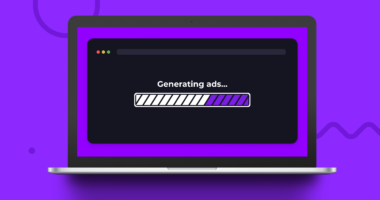This week we are doing things a little bit differently. Instead of our usual article focusing on one subject, we decided to create a digital marketing glossary of basic terms that hopefully will clarify how the industry works.
No banner with provided ID foundIf there are some terms here that you didn’t know before, our advice is that you print the whole article and pin it next to your computer screen, just for a handy reference.
Ad – An ad is a creative way to advertise an offer. There are various ad types:
- push
- pop
- search
- interstitial
- native
Read our article on choosing the best ad type if you want to know more.
Ad network – Sometimes referred to as “ad exchange”. A platform that connects publishers with advertisers. This is a type of a traffic source.
Advertiser – Any person who promotes an offer using traffic in exchange for a payout.
Affiliate marketing – The process of promoting someone else’s products in exchange for a commission. Affiliates usually use paid sources of traffic. If you want to know more about how everything works, read our comprehensive guide to affiliate marketing.
Affiliate network – A platform that connects offer owners and advertisers. This is where you can find offers to promote.
API (Application Programming Interface) – a set of programming codes that enables data transmission between one software and another. Simply, it allows users to view or manipulate resources through a predefined set of request messages.
Blacklist – a list that identifies the placements on which an advertiser does not want his advertising to show up.
Campaign – An organized effort to promote offers. A campaign can have several ads, landing pages, or targeting options, but usually everything is thematically related. Within one campaign, you use one type of ads inside one specific GEO.
Read our guide to launching the first campaign if you want to know more.
Campaign funnel – a complete visitor’s journey, from an ad, through a landing page or pages, to an offer.
Click ID – A unique alphanumeric string that is used to identify a click. Traffic sources, trackers, and affiliate networks have their own click IDs to track concrete visits. Passing a click ID within a token is commonly used to authenticate a conversion within a tracker or a traffic source.
No banner with provided ID foundConversion – Any user-generated event deemed valuable by an offer owner. A conversion can be:
- Purchase
- Newsletter signup
- App install
- Credit card submit
ADVERTISERS are rewarded for conversions by offer owners with a commission, called a “payout”.
Cost models – Methods of paying for traffic. There are the following cost models:
- CPA – Cost per action. This is when you pay for traffic only if a visitor undertook a certain action, usually a conversion.
- CPC – Cost per click. This is when you pay for each click on your ad.
- CPM – Cost per thousand (thousand in latin is mille, hence “Cost per mille”). This is when you pay for a thousand ad views.
- CPV – Cost per view. This is when you pay for a single ad view. CPV times a thousand is CPM.
- Revshare – This is when you pay a set fraction of your payout.
CR (Conversion Rate) – presents how profitable the offer is, so how many users have converted after clicking on the offer.
CTA – Call to action. Usually a button that is placed on a landing page. It directs a visitor to an offer page. There can be one or more CTA buttons that lead to the same or different offers from one landing page.
CTR – Click-through rate. The main indicator of your landing page’s performance. It describes a ratio of people that have clicked the CTA button vs the number of people that have visited the landing page.
Dating – one of the major vertials related to dating, both mainstream and adult.
Direct Tracking – A.k.a. cookieless tracking, redirectless tracking, zero-click tracking. A method of tracking that relies on scripts (often referred to as pixels) that are implemented on a web page, making requests to a tracker when a specific event occurs. This method is faster than a redirect tracking, as there is no redirection in the middle, and more compliant, so you can use it with Google or Facebook. The downside is that you have to edit your landing page’s code to implement this script.
DOI – Double-Opt In. A type of a conversion flow that requires a visitor to perform two steps before a conversion can occur (for example, submitting credit card details and confirming a purchase).
DSP – Demand Side Platform. This is a type of a traffic source that offers traffic not from single publishers, but from various ad networks in one place.
Ecommerce – one of the major verticals related to buying and selling products online.
EPC (Earning Per Click) – a special metric, that shows the average revenue for a single click on the ad.
EPV (Earning Per Visit) – an indicator of how much revenue each visit to the website brings.
GEO – A term describing geographical targeting details, such as tier, country, state, or city.
HTML (Hypertext Markup Language) – a language for building web pages and web applications. The basic knowledge of HTML is required to create a landing page.
HTTP (Hypertext Transfer) – a protocol for communicating with Internet resources. When setting up the campaign funnel using postback URLs, advertisers have to make sure, that the same protocol (either HTTP or HTTPS) is used in all of the links.
iCTR (Impression Click-Through Rate) – illustrates how attractive an ad is to the audience. So, how many users have clicked on the ad after viewing it on a publisher’s side.
Impression – A metric describing a single ad view.
Incentive – Any advertising technique that offers something to a visitor in exchange for an offer. This may include rewards such as virtual currency in games, small payments, exclusive offers, discounts, etc.
Interstitial – A type of full-screen ad, that covers the whole app or page when loaded.
Lander/Landing page – any web page that goes between an ad and an offer. Its purpose is to provide additional product information, convince a visitor to purchase, or present alternative offers. Having a landing page in a campaign funnel usually increases chances for a conversion. If you want to know more, here’s the article about boosting your landing page’s performance.
Lead – Any piece of user information that offer owners deem valuable. This may include email address, phone number, or credit card details.
Leadgen – A type of an offer where the main purpose is to collect leads. In reality, most offers are leadgen offers.
Macros – see: tokens
Native – A type of ad that tries to mimic the surrounding content. These ads look like genuine news articles and are often visible on news pages in sections such as “You may also like” or “Related content”. More on native ads can be found in MGID’s guest post article.
Nutra – One of the main verticals related to health and nutrition products.
Offer – A product or a service that an advertiser can promote in exchange for a commission, called payout. Offers can be found in affiliate networks. If you want to know more, read our article about finding the best offers.
Pixel – This is how a tracking script is usually called. A pixel implemented on a landing page reports visits to this page, whereas a pixel implemented on an offer page reports conversions.
Placeholder – see: tokens
Placement – A place on a web page where an ad is placed. Information about placement is often tracked and used to optimize your campaigns.
Pop – A type of an ad that launches your landing page or offer page in the background (pop-under) or in front of the currently visited page (pop-over).
Postback – A method of reporting conversions from an affiliate network to a tracker or traffic source that uses HTTP requests. The difference between postback and pixel reporting has been covered in our article.
Publisher – A person that has advertising space to sell, such as a web page or app owner. Publishers go to ad networks to offer their advertising space to advertisers.
Push – A type of an ad delivered directly on a visitor’s desktop or mobile displayed in a form of a notification. Push ads aim to act like genuine notifications. Displaying them requires a prior consent from a visitor, which pre-qualifies visitors and usually means higher chances of clicking. If you want to learn more, here’s our article on push ads.
Redirect tracking – A method of tracking that relies on redirects through a tracking domain to correctly record visit data. The visitor’s journey usually looks as follows:
- A visitor clicks an ad;
- This visitor is redirected through a tracking domain to a landing page;
- Once the visitor clicks the CTA button on this page they are redirected through a tracking domain again to the offer.
This method of tracking is considered to be a default one in affiliate marketing and is easy to implement.
ROI – Return on Investment. How much you have earned vs the money you have spent.
- If it’s positive, you are earning money.
- If it’s negative, you are losing money.
It is calculated using the following formula: ROI (%) = (Total revenue ($) – Total cost ($) ) / Total cost ($) * 100%
RON – Run on network is a type of a campaign where you target all traffic coming from one or many countries.
RTB (Real-Time Bidding) – a form of programmatic advertising buying, where media are automatically purchased in an auction-based model, while the website is loading.
Search – A type of ad that mimics the search results displayed on a search engine result page.
SOI – Single opt-in. A type of a conversion flow where a visitor has to make only one step to convert. This usually means agreeing to adding a price of a purchase to their phone bill. The easy conversion flow often means higher conversion rate. The SOI offers are very popular in tier 3 countries.
SSP (Supply Side Platform) – a platform that shares the same technology as a DSP. However, unlike DSPs, SSPs are designed specifically for publishers to manage, sell, and optimize programmatic digital advertising inventory.
Sweeps/Sweepstakes – One of the main verticals related to competitions and quizzes. It is stereotypically associated with the “You won an iPhone!” type of ads.
Tier – A group of countries similar in terms of advertising techniques and payouts. The division is based on when a given country has been connected to the Internet.
- Tier 1 countries are developed countries that were connected to the Internet first. They are familiar with many affiliate techniques and the market in that country is very saturated. However, offers in this Tier have the highest payouts
- Tier 2 countries were connected to the Interned later. Competition is smaller, but still noticeable. And payouts are respectively lower.
- Tier 3 countries are developing countries that got the Internet connection just recently. Offer payouts are the lowest, but competition is lower as well, and the sheer size of a market allows newbies to find niches.
Tokens – An automatically replaceable placeholder that is a part of a redirection URL. It is used to pass information between platforms, such as placement name that a visitor has clicked, country of origin, device type, and many others. Each platform has its own specific tokens.
Tracker – A software design to track affiliate visits, clicks, and conversions and analyze the recorded data. Trackers differ between each other in the way they operate: there can be trackers that you install on your server or there are the ones that operate in a cloud.
If you want to know more, here’s the article about pros and cons of both types of trackers.
Tracking – A process of recording various visit data using either redirect or direct tracking method. More on tracking can be found in our lists of reasons why you need a tracker.
Traffic – a stream of visitors, either paid or organic. A place where you can get traffic from is called a traffic source.
Traffic source – A general term describing any place that you can get traffic from. This includes:
- ad networks
- DSP.
- Google. If you want to know more, please read our guide to Google advertising.
- Facebook. If you want to know more, please read our guide to Facebook advertising.
If you want to find the best traffic source for your campaign, read our beginner guide.
URL (Uniform Resource Locator) – a specific address (reference) for a certain resource on the Internet.
Vertical – An offer category. A subcategory of vertical is called a niche. There are plenty of various verticals, chief among which are dating, nutra, or sweepstakes. Affiliate networks usually specialize in one or few verticals. You have to decide which vertical you want to work with before you launch any campaign. The most profitable verticals for the 2020’s are listed in our article.
Whitelist – a list of placements (widgets, website domains or applications) that an advertiser wants to serve his ads on.





One comment
Thank you for the post. I will definitely comeback.